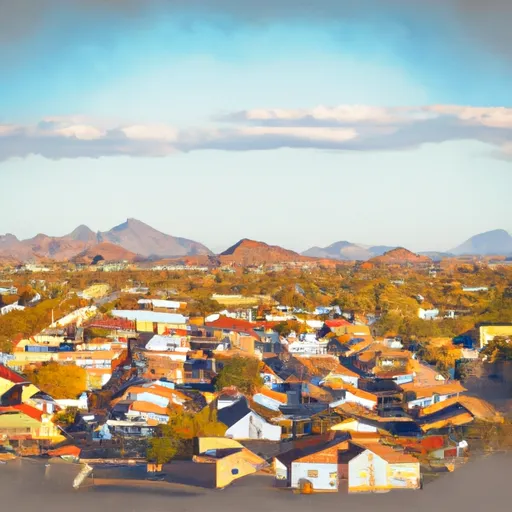-
 Snoflo Premium
Snoflo Premium
Get unlimited access to all our content
With no Ad interruptions! - Start Your Free Trial Login with existing account
Sierra-Vista
Eden Index
Climate
9.1
•
Recreation
5.9
•
Community
2.1
•
Safeguard
6.2/10

Sierra Vista, Arizona is a vibrant city located in the southeastern region of the state. With a population of approximately 45,000 residents, Sierra Vista offers a variety of attractions and opportunities for outdoor enthusiasts.
The climate in Sierra Vista can be described as a semi-arid desert climate. Summers are hot and dry, with temperatures often exceeding 100°F (38°C). Winters are mild, with temperatures ranging from 40-60°F (4-15°C). The monsoon season, which occurs from July to September, brings occasional thunderstorms and provides relief from the arid conditions.
The city's hydrology constituents are primarily influenced by the San Pedro River, a vital water source that flows through Sierra Vista. This river supports a diverse ecosystem and provides recreational opportunities such as fishing, bird-watching, and kayaking.
Sierra Vista is surrounded by stunning natural landscapes, including the nearby Huachuca Mountains. These mountains offer numerous outdoor recreation opportunities, such as hiking, camping, and wildlife spotting. Additionally, Ramsey Canyon Preserve, located just outside Sierra Vista, is renowned for its unique bird species and offers nature trails for exploration. With its favorable climate and abundant outdoor activities, Sierra Vista is an ideal destination for nature lovers and adventure seekers.
What is the Eden Index?
The Snoflo Eden Index serves as a comprehensive rating system for regions, evaluating their desirability through a holistic assessment of climate health, outdoor recreation opportunities, and natural disaster risk, acknowledging the profound impact of these factors on livability and well-being.
Climate Health Indicator (CHI): 9.1
Sierra-Vista receives approximately
343mm of rain per year,
with humidity levels near 53%
and air temperatures averaging around
17°C.
Sierra-Vista has a plant hardyness factor of
8, meaning
plants and agriculture in this region tend to thrive here all year round.
By considering the ideal temperature range, reliable water supplies, clean air, and stable seasonal rain or snowpacks, the Climate Health Indicator (CHI) underscores the significance of a healthy climate as the foundation for quality living.
A healthy climate is paramount for ensuring a high quality of life and livability in a region, fostering both physical well-being and environmental harmony. This can be characterized by ideal temperatures, reliable access to water supplies, clean air, and consistent seasonal rain or snowpacks.
Weather Forecast
Streamflow Conditions
San Pedro-Willcox
Area Rivers
San Pedro-Willcox
Snowpack Depths
San Pedro-Willcox
Reservoir Storage Capacity
San Pedro-Willcox
Groundwater Levels
Recreational Opportunity Index (ROI): 5.9
The Recreational Opportunity Index (ROI) recognizes the value of outdoor recreational options, such as parks, hiking trails, camping sites, and fishing spots, while acknowledging that climate plays a pivotal role in ensuring the comfort and consistency of these experiences.
Access to outdoor recreational opportunities, encompassing activities such as parks, hiking, camping, and fishing, is crucial for overall well-being, and the climate plays a pivotal role in enabling and enhancing these experiences, ensuring that individuals can engage in nature-based activities comfortably and consistently.
Camping Areas
| Campground | Campsites | Reservations | Toilets | Showers | Elevation |
|---|---|---|---|---|---|
| Garden Canyon Military - Fort Huachuca | None | 4,888 ft | |||
| Reef Townsite | 14 | 7,166 ft | |||
| Apache Flats Military - Fort Huachuca | None | 4,949 ft | |||
| Kartchner Caverns State Park | 62 | 4,572 ft | |||
| Lakeview | 65 | 5,452 ft | |||
| Ramsey Vista | 8 | 7,433 ft |
Nearby Fishing
Nearby Ski Areas
Catastrophe Safeguard Index (CSI):
The Catastrophe Safeguard Index (CSI) recognizes that natural disaster risk, encompassing floods, fires, hurricanes, and tornadoes, can drastically affect safety and the overall appeal of an area.
The level of natural disaster risk in a region significantly affects safety and the overall livability, with climate change amplifying these risks by potentially increasing the frequency and intensity of events like floods, fires, hurricanes, and tornadoes, thereby posing substantial challenges to community resilience and well-being.
Community Resilience Indicator (CRI): 2.1
The Community Resilience Indicator (CRI) recognizes that education, healthcare, and socioeconomics are crucial to the well-being of a region. The CRI acknowledges the profound impact of these elements on residents' overall quality of life. By evaluating educational resources, healthcare accessibility, and economic inclusivity, the index captures the essential aspects that contribute to a thriving community, fostering resident satisfaction, equity, and social cohesion.

